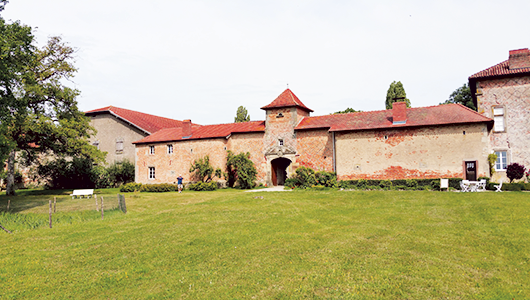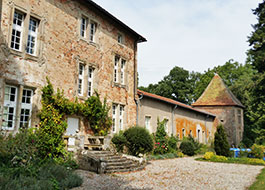Azoudange
Durée visite : 40 minutes
Moyen : Pédestre
Son nom vient d’une personne germanique Ansold suivi du suffixe -ing francisé en -ange. Une voie romaine passait sur le site du village. Au Moyen-âge, Azoudange appartenait à la châtellenie de Fribourg, ancienne place forte et domaine des évêques de Metz. Fribourg-l’Evêque, ancien nom de Fribourg était une ville libre de tout subside. La châtellenie était composée de quatre villages Fribourg, Languimberg, Azoudange et Rhodes.
Les terres de Romécourt, situées sur la commune, furent érigées en fief par le cardinal de Lorraine, puis attribuées à Michel l’Enfant qui y fit construire le château de Romécourt au XVIe siècle L’église Notre-Dame-de-la-Nativité date du XVIIIe siècle. Elle abrite une statue et un buste-reliquaire de sainte Colombe du XVIIIe siècle.
Its name comes from a Germanic person Ansold followed by the suffix -ing francized in -ange. A Roman road passed on the site of the village. In the Middle Ages, Azoudange belonged to the châtellenie of Friborg, a former stronghold and domain of the bishops of Metz. Friborg-l’Evêque, the former name of Friborg, was a city free from all subsidies. The chatellenie was made up of four villages Friborg, Languimberg, Azoudange and Rhodes.
The lands of Romécourt, located in the town, were erected as a fiefdom by the Cardinal of Lorraine, then attributed to Michel l’Enfant who built the Romécourt castle there in the 16th century The Church of Notre-Dame-de-la-Nativité dates from the 18th century. It houses a statue and a bust-reliquary of Saint Colombe from the 18th century.
Sein Name stammt von einer germanischen Person Ansold, gefolgt von dem in -ange francierten Suffix -ing. An der Stelle des Dorfes führte eine Römerstraße vorbei. Im Mittelalter gehörte Azoudange zur Châtellenie von Freiburg, einer ehemaligen Festung und Domäne der Bischöfe von Metz. Freiburg-l’Evêque, der frühere Name Freiburg, war eine Stadt ohne jegliche Subventionen. Die Chatellenie bestand aus vier Dörfern Freiburg, Languimberg, Azoudange und Rhodos.
Das in der Stadt gelegene Land Romécourt wurde vom Kardinal von Lothringen als Lehen errichtet und dann Michel l’Enfant zugeschrieben, der dort im 16. Jahrhundert das Schloss Romécourt errichtete. Die Kirche Notre-Dame-de-la-Nativité stammt aus dem 18. Jahrhundert. Es beherbergt eine Statue und ein Büstenreliquiar von Saint Colombe aus dem 18. Jahrhundert.

Parti de gueules au saumon d’argent et d’argent à la croix de gueules.
A dextre, le saumon est l’emblème de la maison de Blâmont, qui posséda Azoudange ; à senestre, la croix rappelle que la localité a dépendu de la Châtellerie de Fribourg.
Party of gules with the silver salmon and argent with the cross of gules.
On the right, the salmon is the emblem of the house of Blâmont, which owned Azoudange; to the sinister, the cross recalls that the locality depended on the Châtellerie de Friborg.
Party von Gules mit dem silbernen Lachs und Argent mit dem Kreuz von Gules.
Rechts ist der Lachs das Wahrzeichen des Hauses Blâmont, dem Azoudange gehörte. Für die Unheimlichen erinnert das Kreuz daran, dass der Ort von der Châtellerie de Fribourg abhing.

Lé fritcho = les fritures.
Par fritures, il est fait allusion aux bonnes odeurs de lard frit qui s’échappent des maisons et embaument les alentours.
Selon une version ironique, il s’agit de la friture, c’est-à-dire des goujons qu’on attrape dans le petit ruisseau de la Boule.
Réf. Les Evangiles d’ Imling
Lé fritcho = fried foods.
By fried foods, we allude to the good smells of fried bacon that escape from the houses and perfume the surroundings.
According to an ironic version, it is the frying, that is to say the studs that one catches in the small stream of the Boule.
Ref. The Gospels of Imling
Lé fritcho = frittierte Lebensmittel.
Mit frittiertem Essen spielen wir auf die guten Gerüche von gebratenem Speck an, die aus den Häusern entweichen und die Umgebung parfümieren.
Nach einer ironischen Version geht es um das Braten, also um die Bolzen, die man im kleinen Bachbach fängt.
Ref. Die Imling-Evangelien
Les points de visites
.
Le château a été construit par Michel l’Enfant en 1564 . Il est ensuite complété aux XVIIe et XIXe siècles. Les aménagements des écuries, l’intérieur de la chapelle sont les principales modifications. Fait rare et exceptionnel pour un château de Lorraine, la bâtisse est tout en briques. Renaissance oblige, la façade reprend des motifs géométrique en losanges. On les retrouve notamment sur les portes. L’accès au château est permis par les portes de France et d’Allemagne. Elles sont construites en pierres de taille. Le travail de bossage rappelle la situation géographique du château de Romécourt. Il est situé près d’une ancienne frontière entre France et Allemagne. Le domaine de Romécourt s’étend sur 300 hectares de forêts, de champs. On y trouve encore les traces de deux gorges creusées. Elles servaient à extraire la terre pour la fabrication des briques. Il en était de même pour les tuiles du château. La chapelle du château a été lieu de culte de la paroisse jusqu’en 1793. Un des vitraux représente Saint-Louis et Hugues de Martimprey accompagnant le roi aux croisades. Depuis 1698, la chapelle castrale a servi de sépulture à la famille de Martimprey de Romécourt.
Visites possibles sur réservation au prix de 3 € par personne.
The castle was built by Michel 1’Enfant in 1564. It was then completed in the 17th and 19th centuries. The main changes are the fittings of the stables and the interior of the chapel. Rare and exceptional for a Lorraine castle, the building is all in brick. Renaissance obliges, the facade takes again geometric patterns in diamonds. They are found in particular on doors. Access to the castle is permitted through the gates of France and Germany. They are built in freestone. The embossing work recalls the geographical location of the Château de Romécourt. It is located near a former border between France and Germany. The Romécourt estate extends over 300 hectares of forests and fields. There are still traces of two dug gorges. They were used to extract the earth for the manufacture of bricks. It was the same for the tiles of the castle. The chapel of the castle was a place of worship for the parish until 1793. One of the stained-glass windows depicts Saint-Louis and Hugues de Martimprey accompanying the king to the crusades. Since 1698, the castle chapel has served as a burial place for the family of Martimprey de Romécourt.
Visits possible by reservation at a price of € 3 per person.
Die Burg wurde 1564 von Michel l´Enfant erbaut. Es wurde dann im 17. und 19. Jahrhundert fertiggestellt. Die wichtigsten Änderungen sind die Ausstattung der Ställe und das Innere der Kapelle. Selten und außergewöhnlich für ein lothringisches Schloss, ist das Gebäude ganz aus Ziegeln. Renaissance verpflichtet, nimmt die Fassade wieder geometrische Muster in Diamanten. Sie sind insbesondere an Türen zu finden. Der Zugang zum Schloss ist durch die Tore Frankreichs und Deutschlands gestattet. Sie sind aus Naturstein gebaut. Die Präge erinnert an die geografische Lage des Château de Romécourt. Es liegt in der Nähe einer ehemaligen Grenze zwischen Frankreich und Deutschland. Das Landgut Romécourt erstreckt sich über 300 Hektar Wald und Felder. Es gibt noch Spuren von zwei gegrabenen Schluchten. Sie wurden verwendet, um die Erde für die Herstellung von Ziegeln zu gewinnen. So war es auch mit den Fliesen des Schlosses. Die Schlosskapelle war bis 1793 eine Kultstätte der Gemeinde. Eines der Buntglasfenster zeigt Saint-Louis und Hugues de Martimprey, die den König zu den Kreuzzügen begleiteten. Seit 1698 dient die Schlosskapelle als Grabstätte für die Familie von Martimprey de Romécourt.
Besuche nach vorheriger Reservierung zum Preis von 3 € pro Person möglich.
.






